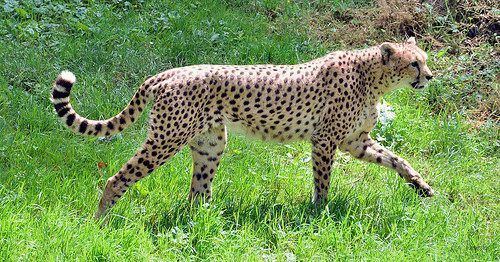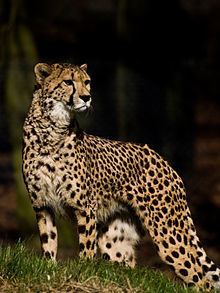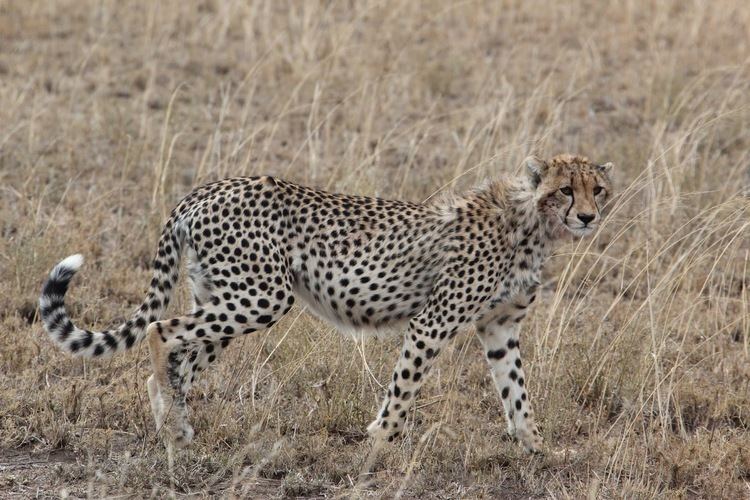Kingdom Animalia Order Carnivora Genus Acinonyx Rank Subspecies | Phylum Chordata Family Felidae Higher classification Cheetah | |
 | ||
Scientific name Acinonyx jubatus soemmeringii Similar Cheetah, Northwest African cheetah, Felidae, South African cheetah, Mammal | ||
The Sudan cheetah (Acinonyx jubatus soemmeringii) is a cheetah subspecies native to Central and Northeast Africa. It lives grasslands, savannahs, lowlands of the Nile Valley, inland Lake Chad, arid Sahelian and Saharan deserts and steppes. Its population is fragmented in several areas of South Sudan, Ethiopia, Chad, Somalia and the Central African Republic. It is also nearly extinct in Sudan. Other common names are Somali cheetah, Northeast African cheetah or Central African cheetah. The Sudan specimen was first described by the Austrian zoologist Leopold Fitzinger under the scientific name Cynailurus soemmeringii in Bayuda Desert of colonial Sudan in 1855.
Contents
- Taxonomy
- Evolutionary history
- Physical characteristics
- Habitat and distribution
- Population
- Former ranges
- Hunting and diet
- Enemies and competitors
- Tamed cheetahs
- Threats
- Conservation
- Ethiopian Wildlife Conservation
- Semi captive breeding program
- Rewilding project in Arabia
- In captivity
- References

Once widespread throughout central to northeast Africa, it was driven to extinction in Cameroon, Nigeria, Egypt and northern Democratic Republic of the Congo. In the 1970s, the Sudan cheetah population of the Northeast region was estimated at 1,150 to 4,500 individuals. Since 2002, it is classified as Vulnerable by IUCN, due to low densities, habitat loss and being smuggled from the Horn of Africa to the Middle East, and the Sudan cheetah population has been estimated at fewer than 2,000 cheetahs in the wild. The population is still increasing slowly due to conservation efforts and breeding programs in Europe and the Middle East.

Once thought to be genetically identical to other Sub-Saharan cheetahs, it has been revealed that the Sudan cheetah is a distinct subspecies after being separated from their Southern African relative between 16,000 and 72,000 years ago.

Taxonomy
In 1855, the cheetah subspecies living in Northeast and Central Africa were first described by Austrian zoologist Leopold Fitzinger. He proposed the trinomen Cynailurus soemmeringii for a cheetah he found at Kababish, south of the Bayuda Desert of northern Kordofan region in Sudan. He named the subspecies after German physicist Samuel Thomas von Soemmerring, who is also a member of the Senckenberg Natural History Society. The subspecies may also be respectively known as "Soemmerring's cheetah". The spelling with a single "r" in "A. j. soemmeringii" thus a lapsus; both it and proper attribution of the name were later subjects of correction by Fitzinger since 1869.
Prior and following Fitzinger's description of a Sudan cheetah skin from the Kordofan region of Sudan, other naturalists and zoologists also described cheetahs from other parts of Northeast Africa that today are all considered synonyms of A. j. soemmeringii:
Evolutionary history
The closest relative of the Sudan cheetah is the South African cheetah (Acinonyx jubatus jubatus). It was unknown whether or not the subspecies from Sudan is genetically different from other cheetah population from other African regions and Iran to deserve their status as a separate subspecies. It has been revealed that the Northeast African cheetahs to be a completely distinct subspecies in January 2011, having been diverged from their Southern African cousins between 16,000 and 72,000 years ago, therefore is distinguish from their closest neighbors from Iran, the Asiatic cheetahs (Acinonyx jubatus venaticus). It was also discovered that the Northeast African cheetahs had a lot in common with the Saharan cheetahs from West Africa.
Physical characteristics
The Sudan cheetah, along with the Tanzanian cheetah, rank among the largest subspecies. Certain cheetahs can be smaller or medium-sized. Its characteristics resembles the Tanzanian cheetah the most, it has a densely ochraceous spotted coat with relatively thick and coarse fur in comparison to its relatives from eastern and northwestern Africa. The belly of the Sudan cheetah is distinctly white while its breasts and throat can have some black spots similar to the eastern subspecies. However, it is the darkest in fur color. The Sudan cheetah has the most widespread and separated black dorsal spots but smaller than that of the Tanzanian cheetah's. In contrasts to the Tanzanian cheetah, the Sudan cheetah has no spots on the hind feet, although some among the Chadian population has hind legs nearly always spotted. This cheetah has distinct white patches around its eyes but the facial spotting can vary from very dense to relatively thin. The Sudan cheetah has been seen with both white and black tipped tails, although certain Sudan cheetahs' tails are white tipped. This subspecies' tail is also notably thick.
This subspecies has the largest head size, but sometimes can get relatively smaller. However, it does not have mustache markings. The tear marks of the Sudan cheetah are highly inconsistent, but they are frequently thickest at the mouth corners than the other four subspecies, making them quite unique.
The Sudan cheetah is the only subspecies not being reported to show a rare color variation. However, despite having the darkest fur color, certain Sudan cheetahs' fur color can be pale yellow or almost white as well.
In cold climates, such as in Whipsnade Zoo, Sudan cheetahs are the only African subspecies that can develop fluffy winter fur coats especially at very young age, though they are less developed than that of the Asiatic cheetah's.
Habitat and distribution
Sudan cheetahs live in wide open lands, grasslands, semi-arid areas, and other open habitats where there is a large density of prey. Native to North Africa, they also live in East Sudanian savannahs, the mountainous regions of Tibesti, the Sahelian and Saharan deserts, woodlands, steppes, including in regions of very hot tropical, humid and drier climate.
Population
It is known there is the estimated total population of approximately 2,000 Sudan cheetahs in the wild, and there are apparently more in Ethiopia. There is lower density in their current locations in other countries. The cheetahs are rarely seen in northern regions of Sudan, today they occur mostly on South Sudan. Wild cheetahs have been spotted in An Nil al Azraq, in the southeast region of Sudan.
Most Sudan cheetahs live in Omo Mago and Borena buffer zones and Afar, Ogaden and Yangudi Rassa landscapes of Ethiopia. In Central Africa, it is estimated that 217 individuals live in the Bahr and Salamat landscapes of Chad and the Central African Republic. Although cheetahs are rarely seen outside of protected areas, they can be spotted in various national parks and reserves, such as Bamingui-Bangoran and Manovo-Gounda St. Floris National Park in the Central African Republic, the Boma National Park, the Bandingilo National Park and Southern National Park in South Sudan, the Blen-Afar National Park and Gambela National Park in Ethiopia, the Fada Archei and Ouadi Rimé-Ouadi Achim Faunal Reserve in Chad, and the Dinder National Park and Radom National Park in Sudan. In eastern Niger, the Sudan cheetahs are found in the Termit Massif Reserve.
Former ranges
The Sudan cheetahs used to be widespread everywhere in central and northern Africa, ranging from the northern Democratic Republic of the Congo to Egypt. Currently, the population have lower density in their countries, unlike their eastern and southern cousins which are the most common, whilst the Northwest African and Asiatic cheetahs are listed as critically endangered.
Other than those countries, the Northeast African cheetahs have been found in Eritrea, Djibouti, northern Somalia, Libya and Egypt. The subspecies might even shared borders with Northwest African and Tanzanian cheetahs. However, currently in the 21st century, the cheetah subspecies are regionally extinct in Libya. Yankari National Park used to be the last remaining cheetah habitat in Nigeria. The Sudan cheetahs have gone extinct from the Garamba National Park of the Orientale Province in Northeast Congo in the 1960s.
The cheetahs are often stated to be extinct in Egypt, although sightings of Northern cheetahs has been reported several times at the northern, western and northwestern parts of Qattara Depression. Finally, a conservation action plan was prepared for the cheetah and gazelle sancturary of present cheetah habitats in northwestern Qattara Depression.
Recently in July 2010, it was confirmed that the Northern cheetah, including the African wild dogs to be locally extinct in Cameroon. Waza National Park and the Bénoué ecosystem were one of the last habitats for Sudan cheetahs. The cheetahs, formerly extinct from Djibouti, are being reintroduced and bred at a wildlife refuge of the country. It is officially extinct in Eritrea.
Hunting and diet
The Sudan cheetahs are carnivorous and mostly feed on herbivorous animals, such as Grant's gazelles, Cape hares, guineafowls and large animals like hartebeests, plains zebras and Barbary ostriches on few occasions. The Soemmerring's gazelles are the most preferable prey. However, lack of Soemmerring's gazelles in the Sudan cheetah's region caused near extinction in Sudan.
Enemies and competitors
Like all cheetahs, Sudan cheetahs are threatened and outranked by larger predators in their area. They are threatened by lions, leopards, spotted hyenas and African wild dogs, as they can kill cheetahs and steal their carcasses. The cheetahs would surrender their meals to spotted and striped hyenas. Cheetahs are known to be unable to defend themselves against these predators. However, coalitions of male adult cheetahs can chase predators away. Although, a single cheetah can chase jackals, golden wolves and a lone wild dog away.
Tamed cheetahs
Both continents of Africa and Asia had 100,000 cheetahs in the 19th century. Sudan cheetahs were once numerous in north, central and in the Horn of Africa. They ranged in Egypt and Libya on northern Africa, from Somalia to Niger on northeastern and central Africa. Cheetahs are known to be tamed, trained and to hunt herbivorous animals. Once existed in Egypt, the Ancient Egyptians often kept the cheetahs and raised them as pets, and also tamed and trained them for hunting mammals. Tamed cheetahs were taken to open hunting fields in low-sided carts or by horseback, hooded and blindfolded, and kept on leashes. When the prey was near enough, the cheetahs would be released to go after it.
This was the Egyptian tradition that was later passed on to the ancient Persians and brought to India, where the practice with Asiatic cheetahs was continued by Indian princes into the 12th century.
Threats
Like other cheetah subspecies, the Sudan cheetahs are threaten by illegal wildlife trade, hunting, poaching, habitat loss, lower densities of the population and lack of prey which reduces their numbers, making them hard and rare to spot them in the wild. These animals can be highly threaten by other predators such as lions, leopards, African wild dogs and hyenas, as they could kill the cheetahs or steal their food.
The Sudan cheetah is also highly threatened by illegal pet trade from Somaliland. Cheetah cubs can be sold on the black market for over $10,000 but rescuing a single cub costs over three times that much, and the majority of captive cheetah cubs may die before they ever leave Africa. Though it is known that there are an increasing rate of Northeast African cheetah cubs mostly from Somaliland being smuggled into the Middle Eastern countries, such as Saudi Arabia, the United Arab Emirates and especially Yemen. Fortunately, captive breeding projects in Europe and in the Middle East are slowly increasing their numbers and have been successful so far.
Conservation
The Sudan cheetah is currently listed as vulnerable in the IUCN Red List of Threatened Animals. There are breeding programs from Europe and the Middle East for the Sudan cheetah, such as the European Endangered Species Programme (EEP) which is reserved for European Association of Zoos and Aquaria (EAZA). The breeding programs have been successful. The captive breeding projects for the Northern cheetah first started in the Middle East, after several years of population of Sudan cheetah decreasing due to cubs being used for commercial purposes. Then European zoos started afterwards once the captive-born Sudan cheetahs from the Arabian peninsula were sent to Zoological collections of Europe in Netherlands and Germany.
Ethiopian Wildlife Conservation
The Sudan cheetah, including the African wild dog are considered as emblematic to Ethiopia. A conservation project for wild animals started first in 2006 after "real lack of awareness in Ethiopia about the treatment of animals". The conservation goal is to ensure the increasing populations of cheetahs and other threatened wild animals in Ethiopia. Following the illegal pet trade of cheetah cubs of Somaliland to the Middle East, the Ethiopian Born Free Foundation had confiscated the cheetah cubs from Somalia and started a semi-captive breeding project for them in order to save the species and reintroduce them into the wild. The rescued Somali cheetahs reside at Ensessakotteh in a spacious enclosure.
Semi-captive breeding program
There is a reproduction programme for the Sudan cheetahs at the Djibouti Cheetah Refuge in Djibouti City, which first started in 2004. The Djibouti Cheetah Refuge (also known as DECAN Cheetah Refuge) was first constructed in 2002 and the initial phase was opened in a year later.
Rewilding project in Arabia
There is also a rewilding project from the Breeding Centre for Endangered Arabian Wildlife for the Sudan cheetahs breeding in wildlife parks and those in captivity in the Middle-East, such as in the Arabian Wildlife Park from Sir Bani Yas, the Al-Ain Zoo and Sharjah's Arabian Wildlife Centre from the United Arab Emirates.
Cheetahs once lived in the Arabian Peninsula until they became regionally extinct everywhere in the wild of the Middle-East in the early 1970s. The rewilding project officially started in 2008, when four captive-born Sudan cheetahs have been reintroduced into the wild of Sir Bani Yas Island to roam free and maintain natural balance. The cheetahs are taught to breed, to survive and feed on goitered and mountain gazelle on their own, then their offsprings would successfully learn those instincts from their parents.
Cheetahs are known to be difficult to breed and therefore, the survival rate of cheetah cubs are low in the wild and in captivity. However, the project has been successful so far. In April 2010, the first four Sudan cheetah cubs have been born on the island from a successfully rewilded Sudan cheetah mother named Safira. According to conservation team, the cubs' mother have done an impressive job in taking care of her children. The cubs are recognized to be the first wild-born cheetahs to ever been born in Arabia after 40 years ago.
The Al-Wabra Wildlife Preservation (AWWP) from Qatar, Al-Dhaid Wildlife Centre from Sharjah, the Nakelee Wildlife Centre and the Wadi Al-Safa Wildlife Centre from Dubai are also part of the international breeding programme to help save the rare Sudan cheetah population which are breeding in captivity. The breeding programmes of the Middle-East are aiming to release the Sudan cheetah into the wild of Africa. There are currently 23 adult and 7 cubs in Wadi Al-Safa.
In captivity
Cheetahs are known to be difficult to breed, especially in captivity. The Sudan cheetah has been breeding in captivity for many years in Arabian zoos, such as Al Ain Zoo and Arabian wildlife centers from Qatar, Sharjah and Dubai. The Northern cheetahs breeding in European zoos are found at Zoo Landau and Tierpark Berlin from Germany, the Chester Zoo, Bristol Zoo, Whipsnade Zoo and Marwell Zoo from the United Kingdom, Zoo de Cerza, Parc zoologique de Bordeaux Pessac and La Palmyre Zoo from France, the Plzeň Zoo from the Czech Republic, Zoo Santo Inácio from Portugal, the DierenPark Amersfoort and Beekse Bergen Safari Park from Netherlands. The Fota Wildlife Park from Ireland, which bred hundreds of South African cheetahs, has bred its first Northern cheetah in 2013.
The first captive breeding projects for the Northeast African cheetah started in Sheikh Butti Al-Maktoum's Wildlife Centre in early 1994, then followed by the Sharjah's Arabian Breeding Centre in late 2002, until captive-bred Sudan cheetahs from the Middle East were sent to two European zoos, Zoo Landau and Beekse Bergen Safari Park. La Palmyre Zoo would receive the cheetahs 6 months later as well.
